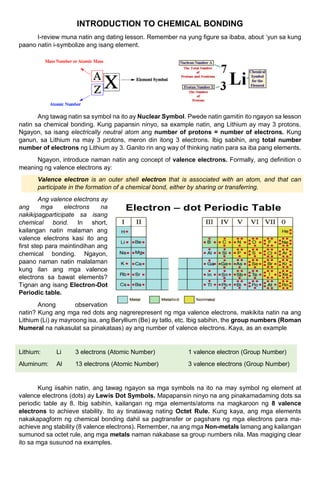
Introduction to Chemical Bonding - TAGLISH Version
- 1. INTRODUCTION TO CHEMICAL BONDING I-review muna natin ang dating lesson. Remember na yung figure sa ibaba, about ‘yun sa kung paano natin i-symbolize ang isang element. Ang tawag natin sa symbol na ito ay Nuclear Symbol. Pwede natin gamitin ito ngayon sa lesson natin sa chemical bonding. Kung papansin ninyo, sa example natin, ang Lithium ay may 3 protons. Ngayon, sa isang electrically neutral atom ang number of protons = number of electrons. Kung ganun, sa Lithium na may 3 protons, meron din itong 3 electrons. Ibig sabihin, ang total number number of electrons ng Lithium ay 3. Ganito rin ang way of thinking natin para sa iba pang elements. Ngayon, introduce naman natin ang concept of valence electrons. Formally, ang definition o meaning ng valence electrons ay: Valence electron is an outer shell electron that is associated with an atom, and that can participate in the formation of a chemical bond, either by sharing or transferring. Ang valence electrons ay ang mga electrons na nakikipagparticipate sa isang chemical bond. In short, kailangan natin malaman ang valence electrons kasi ito ang first step para maintindihan ang chemical bonding. Ngayon, paano naman natin malalaman kung ilan ang mga valence electrons sa bawat elements? Tignan ang isang Electron-Dot Periodic table. Anong observation natin? Kung ang mga red dots ang nagrerepresent ng mga valence electrons, makikita natin na ang Lithium (Li) ay mayroong isa, ang Beryllium (Be) ay tatlo, etc. Ibig sabihin, the group numbers (Roman Numeral na nakasulat sa pinakataas) ay ang number of valence electrons. Kaya, as an example Lithium: Li 3 electrons (Atomic Number) 1 valence electron (Group Number) Aluminum: Al 13 electrons (Atomic Number) 3 valence electrons (Group Number) Kung iisahin natin, ang tawag ngayon sa mga symbols na ito na may symbol ng element at valence electrons (dots) ay Lewis Dot Symbols. Mapapansin ninyo na ang pinakamadaming dots sa periodic table ay 8. Ibig sabihin, kailangan ng mga elements/atoms na magkaroon ng 8 valence electrons to achieve stability. Ito ay tinatawag nating Octet Rule. Kung kaya, ang mga elements nakakapagform ng chemical bonding dahil sa pagtransfer or pagshare ng mga electrons para ma- achieve ang stability (8 valence electrons). Remember, na ang mga Non-metals lamang ang kailangan sumunod sa octet rule, ang mga metals naman nakabase sa group numbers nila. Mas magiging clear ito sa mga susunod na examples.
- 2. IONIC BONDING Gagamitin natin ngayon itong mga Lewis Dot Symbols para malaman natin ang chemical bonding. As an example, ang mga lewis dot symbols ng Na (sodium) at Cl (chlorine) ay makikita niyo sa baba. Gaya ng sinabi natin, ang non-metal kailangan magfollow ng Octet Rule, kaya kailangan niya ng 8 valence electrons. Kung mayroon na ang Cl (chlorine, non metal) ng 7 valence electrons, 1 nalang kailangan niya para magkaroon ng 8 valence electrons. Sa Na (sodium, metal) naman, dahil under ito ng Group Number 1, ay mayroong 1 valence electrons, may magandang ipamigay (transfer) nalang niya ang nag iisang valence electron para ma-achieve ang stability. Ito ang nirerepresent ng arrow – transfer of electrons. Ionic Bonding: metal + non-metal = ionic compound Transfer of electrons = formation of ionic bond Ionic bonding is the complete transfer of valence electron(s) between atoms. It is a type of chemical bond that generates two oppositely charged ions. In ionic bonds, the metal loses electrons to become a positively charged cation, whereas the nonmetal accepts those electrons to become a negatively charged anion. COVALENT BONDING Kagaya nang example natin sa Ionic Bonding, pareho lang ang logic at principles na gagamitin natin para sa covalent bonding. Ipapakita na lang natin ang kaibahan nila. As an example, gagamitin natin ang dalawang atoms ng Cl (chlorine, non metal) na may 7 valence electrons. Ngayon, para ma- achieve nila ang stability, pareho nilang kailangan ang 1 valence electron para magkaroon ng 8 valence electrons. Kaya ang gagawin nila, magshe-share sila ng 1 valence electrons, kagaya ng nakikita niyo sa picture sa baba. Covalent Bonding: non-metal + non-metal = covalent compound Sharing of electrons = formation of ionic bond A covalent bond is a chemical bond that involves the sharing of electron pairs between atoms. Covalent bonding generally happens between nonmetals